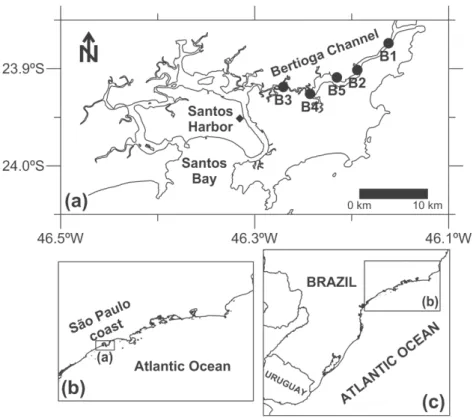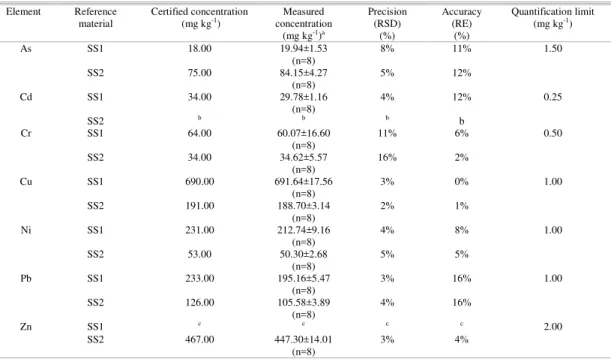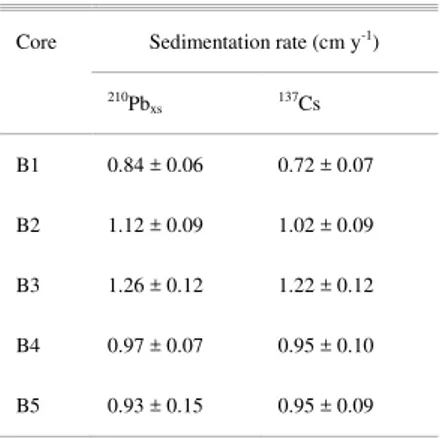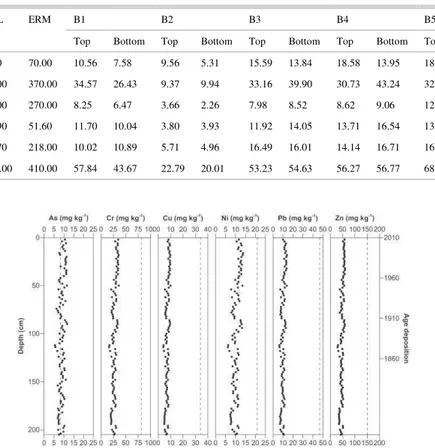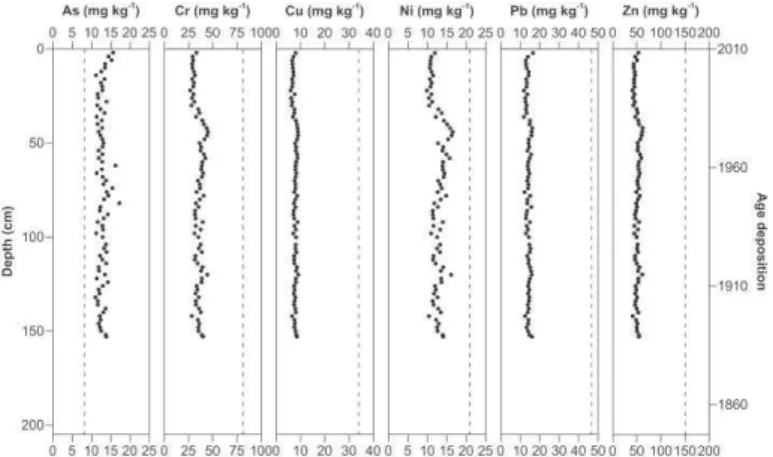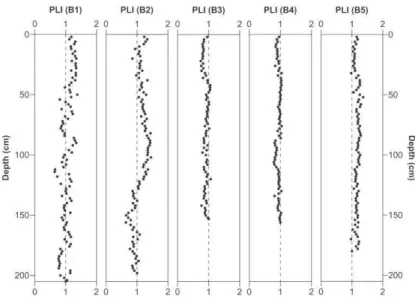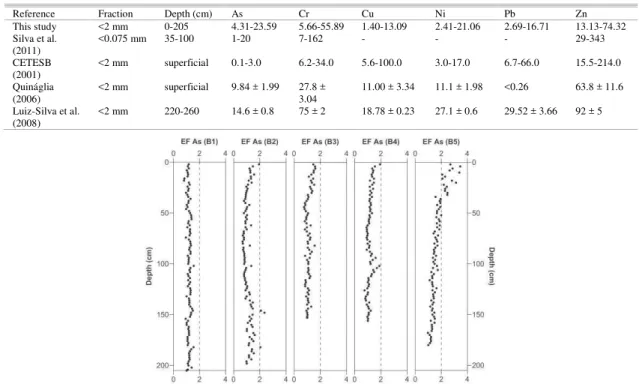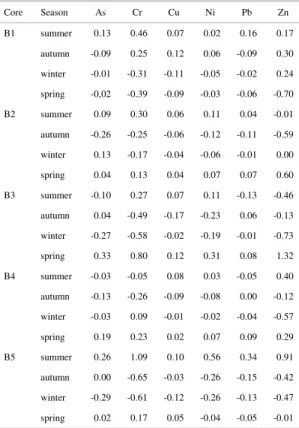RECONSTRUCTION OF HISTORICAL TRENDS IN POTENTIALLY TOXIC
ELEMENTS FROM SEDIMENT CORES COLLECTED IN
BERTIOGA CHANNEL, SOUTHEASTERN BRAZIL
Cristina Gonçalves1, Rubens Cesar Lopes Figueira2, Juliê Rosemberg Sartoretto2, Alexandre Barbosa Salaroli
2
, Andreza Portella Ribeiro3, Paulo Alves de Lima Ferreira2,* and Michel Michaelovitch de Mahiques2
1Consultoria, Planejamento e Estudos Ambientais (CPEA)
(Rua Henrique Monteiro, 90, São Paulo, SP, Brasil)
2Instituto Oceanográfico da Universidade de São Paulo
(Praça do Oceanográfico, 191, 05508-120 São Paulo, SP, Brasil)
3Curso de Gestão Ambiental e Sustentabilidade, Universidade Nove de Julho (UNINOVE)
(Av. Francisco Matarazzo, 612, prédio C, andar térreo, Água Branca, São Paulo, SP, Brasil) *Corresponding author: paulo.alves.ferreira@usp.br
A
B S T R A C TThe study presents an evaluation of potentially toxic elements deposition in Bertioga Channel (Southeastern Brazilian coast) along the last 150 years, the main anthropogenic activity period in the area. Five sediment cores by means of ICP-OES to determine the levels of metals (Cd, Cr, Cu, Ni, Pb and Zn) and As. The pollution load index (PLI) and enrichment factor (EF) were calculated to identify the relative elements toxicity of the sediments and the anthropogenic contribution of the investigated elements. The indexes indicated the absence of contamination but a higher input of As in cores B2 and B5, which have been sampled in an area that presents higher sedimentation rates. Through an statistical analysis of time series decomposition, it was verified that the metals flux to the area follow the cycles of rainy (austral summer and autumn) and dry seasons (austral winter and spring). In conclusion, the enrichment corresponds to the end of the 19th Century, when Santos Harbor was inaugurated, and to the 1970s, when Santos Harbor activities expanded. In addition, the analysis of the indexes and the temporal decomposition indicate that these elements' input to Bertioga Channel is due to natural processes of weathering and sedimentation.
R
E S U M OEste estudo apresenta uma avaliação da deposição de elementos potencialmente tóxicos no Canal de Bertioga (costa sudeste brasileira) ao longo de 150 anos, período principal de atividade antropogênica na área. O trabalho analisou cinco testemunhos sedimentares por meio de ICP-OES para determinar os níveis de metais (Cd, Cr, Cu, Ni, Pb e Zn) e As. O índice de carga de poluição (PLI) e o fator de enriquecimento (EF) foram calculados para identificar a toxicidade relativa dos elementos dos sedimentos e a contribuição antropogênica dos elementos investigados. Os índices indicaram a ausência de contaminação por metais pesados, mas houve uma entrada mais elevada de As nos testemunhos B2 e B5, amostrados em área com maiores taxas de sedimentação. Através de análise estatística de decomposição de séries temporais, verificou-se que o fluxo de metais para a área segue os ciclos de estações chuvosa (verão austral) e seca (inverno austral). Como conclusão pode ser verificado que o enriquecimento observado corresponde ao final do século XIX, quando o Porto de Santos foi inaugurado, e à década de 1970, quando as atividades do porto foram expandidas. Ainda, a análise dos índices e da decomposição temporal indica que a entrada de As no Canal de Bertioga dá-se por processos naturais de intemperismo e dá-sedimentação.
Descriptors: Potentially toxic elements, Enrichment factor, Sedimentation rates, Bertioga Channel. Descritores: Elementos potencialmente tóxicos, Fator de enriquecimento, Taxa de sedimentação, Canal de Bertioga.
I
NTRODUCTIONThe Baixada Santista, located on the southeastern Brazilian coast, covers an area of approximately 2,423 km² (corresponding to around 1% of São Paulo state). The Baixada Santista is the third most heavily populated region in the state, with a population of 1.6 million distributed in nine cities
(CBH-BS, 2011). Tourist and artisanal fishery activities are also undertaken in the Baixada Santista. Studies in this region have identified the degradation of the environment due to both domestic and industrial pollution, responsible for microbiological and chemical contamination; physical alterations of habitats due to erosion processes, silting up, channels and mangrove embankments; and interventions in the drainage system (CETESB, 2001).
Since sediments act as a major repository of inorganic elements in the aquatic system, the pollution in the aquatic environment of the Baixada Santista has become a concern. Benthic biota is exposed to metallic pollutants accumulated within the sediments, which may transfer potentially toxic concentrations through the food web to organisms on higher trophic levels. The scientific community has shown increasing interest in the area and studies on contamination in sediments have been undertaken and contaminant variability along sedimentary cores has been widely evaluated to assess the history of toxic element pollution in aquatic environments (BORDON et al.,
2011; FUKUMOTO (2007):
http://www.teses.usp.br/teses/disponiveis/21/21133/tde-06112007-110644/publico/Tese_MarinaFukumoto.pdf
HARIKUMAR et al., 2009; HORTELLANI et al., 2008; IRABIEN et al., 2008; LUIZ-SILVA et al.,
2008; SILVA et al., 2011, TORRES,
2007http://www.bdtd.ufscar.br/htdocs/tedeSimplifica do//tde_busca/arquivo.php?codArquivo=2663). Moreover, the levels of toxic elements are subject to variations on a seasonal time scale due to changes in the physical and chemical conditions of the environment (LUIZ-SILVA et al., 2006).
The Bertioga Channel is one of the several channels that constitute the Santos Estuarine Complex (Fig. 1) which is considered a pristine environment. This channel is 24 km long and up to 1 km wide. Whereas the most degraded mangrove forests are located in the Santos region, due to the influence of industrial pollution, one of the least degraded is in the Bertioga Channel (RODRIGUES et al., 1999), which gives the area great potential for the retention of anthropogenic substances.
Within this context, the main goal of this study was to undertake research into the potentially toxic elements in cores from the Bertioga Channel. PLI (pollution load index) and EF (enrichment factor) were determined and compared with the age model obtained for the cores to evaluate the trends of the impact of anthropic activities in this region.
M
ATERIAL ANDM
ETHODSSampling
Five sediment cores were collected along the Bertioga Channel (Fig. 1) in February 2010 using a Rossfelder VT-1 vibracorer. The core lengths ranged from 150 to 220 cm. To obtain undisturbed samples, the cores were sliced every 2 cm using a stainless steel spatula, and the sediment samples were freeze-dried before further handling at LaQIMar (Laboratory of Marine Inorganic Chemistry), located at the Instituto Oceanográfico of the Universidade de São Paulo (IO-USP, São Paulo, Brazil). Half of the sliced cores was used for ICP-OES analyses, and the others were used for radiometric dating.
Inductively Coupled Plasma-optical Emission Spectrometry (ICP-OES)
The SW 846 US EPA 6010C method (UNITED STATES, 2007) allowed the determination of the following elements by ICP-OES using a Varian MPX 710ES model: As, Cd, Cr, Cu, Ni, Pb and Zn. Sc was also determined to calculate the EF values as a normalizer.
The precision and accuracy were proved by the analysis of replicates of the certified reference
materials SS1 and SS2 from EnvironMAT™ CRM
SPC Science. The precision was assessed by the relative standard deviation, below 16% in all of the elements, and the accuracy was achieved by relative error, which was below 16%.
In addition, the quantification limits (QLs) were calculated according to the definition of IUPAC (IUPAC, 1997): QL = (10.sb)/s,in which sb is the standard deviation of 10 background readings and s is the sensibility of the methodology, corresponding to the inclination parameter of the calibration curve made with multiple readings of standard solutions with known concentrations. Table 1 presents these results and the practical quantification limits obtained for the methodology used.
For this analysis, acidified aqueous sample solutions were obtained by leaching 2 g of freeze-dried sediment with HNO3, H2O2 and HCl according to the SW 846 US EPA 3050B method (UNITED STATES, 1996). It is important to mention that this method involves a very strong acid digestion that
dissolves the “environmentally available” elements,
not including only those bound in the silicate structures, which are not usually mobile in the environment.
Table 1. Concentrations of potentially toxic elements (in mg kg-1) in standard reference materials. Quality control and
quantification limits of the methodology.
Element Reference
material Certified concentration (mg kg-1) concentration Measured
(mg kg-1)a
Precision (RSD)
(%)
Accuracy (RE)
(%)
Quantification limit (mg kg-1)
As SS1 18.00 19.94±1.53
(n=8) 8% 11% 1.50
SS2 75.00 84.15±4.27
(n=8) 5% 12%
Cd SS1 34.00 29.78±1.16
(n=8) 4% 12% 0.25
SS2 b b b b
Cr SS1 64.00 60.07±16.60
(n=8) 11% 6% 0.50
SS2 34.00 34.62±5.57
(n=8) 16% 2%
Cu SS1 690.00 691.64±17.56
(n=8) 3% 0% 1.00
SS2 191.00 188.70±3.14
(n=8) 2% 1%
Ni SS1 231.00 212.74±9.16
(n=8) 4% 8% 1.00
SS2 53.00 50.30±2.68
(n=8) 5% 5%
Pb SS1 233.00 195.16±5.47
(n=8) 3% 16% 1.00
SS2 126.00 105.58±3.89
(n=8) 4% 16%
Zn SS1 c c c c 2.00
SS2 467.00 447.30±14.01
(n=8) 3% 4%
a Concentration values represented in the form (mean ± standard deviation). b Not a reference material for this element.
Sedimentation Rates and Sediment Dating
The cores were analyzed for 210Pb, 226Ra and 137Cs by direct gamma assay using an EG&G ORTEC model 25190P hyperpure Ge detector with mean resolution of 1.90 keV for the 1332.40 keV photopeak of 60Co. 210Pb, 226Ra and 137Cs activities were measured at 46.52 keV, 609.31 keV and 661.67 keV, respectively, according to the methodology of analysis and data acquisition described in Figueira et al. (2007).
In this study, the sedimentation rate was calculated with the unsupported 210Pb (210Pb
xs) via CIC (constant initial concentration) model. This model has been set out by Appleby and Oldfield (1978) and Joshi and Shukla (1991), and it is adequately described in the scientific literature. The sedimentation rates obtained by 210Pb
xs are presented in Table 2 and the results were confirmed by 137Cs measurement. From these data, it was possible to establish the dating for samples to understand the behavior of metals and As along each core.
Table 2. Sedimentation rate (in cm y-1)
with 210Pb
xs and 137Cs for the five cores
from Bertioga Channel, Southeastern Brazilian coast.
Core Sedimentation rate (cm y-1)
210Pb
xs 137Cs
B1 0.84 ± 0.06 0.72 ± 0.07
B2 1.12 ± 0.09 1.02 ± 0.09
B3 1.26 ± 0.12 1.22 ± 0.12
B4 0.97 ± 0.07 0.95 ± 0.10
B5 0.93 ± 0.15 0.95 ± 0.09
Sediment Quality Guidelines (SQGs)
The results obtained in this study were compared with the sediment quality guidelines (SQGs) established by Long et al. (1995). These authors empirically defined no-effect concentrations after extensive literature reviews that identified concentrations rarely associated with toxic marine and estuarine sediments. They ranked the values in terms of chemical concentrations at which adverse biological effects were observed: the 10th percentile of the effects data for each contaminant was used to identify a threshold (Effects Range-Low or ERL) below which the effects rarely occurred, and the 50th percentile (median) of the data denoted the concentration
(Effects Range-Median or ERM) above which adverse effects occurred frequently.
The ERL and ERM guidelines have been used widely (BINELLI et al., 2008; BIRCH; TAYLOR, 2002; FORRESTER et al., 2003; HEMMING et al., 2005; HORTELLANI et al., 2008; IRABIEN et al., 2008; LUO et al., 2010; PEKEY et al., 2004; ROACH, 2005; WADE et al., 2008). In the Brazilian environmental regulations, for example, these guidelines correspond to levels 1 and 2 for metals and As, respectively, defined by the CONAMA 344 Resolution (BRASIL, 2004), which establishes the general guidelines and minimal procedures for the evaluation of material to be dredged in the Brazilian
waters and other actions. According to O’Connor
(2004), however, ERL/ERM should not be interpreted in a regulatory context or as criteria for coastal management decisions, but rather to infer associations between chemical contaminants and adverse biological effects and as a framework for follow-up research and monitoring.
It is important to emphasize that the derivation of SQG is hampered by the uncertainties surrounding estimations of the biological availability of sediment-associated contaminants. The actual availability and consequent ecotoxicological effects are strongly influenced by factors such as the grain-size distribution, the composition of organic matter, the occurrence of sulfides and the time interval in which the contaminants are present in the sediment. Therefore, it cannot be concluded that marine sediments with concentrations above these no-effect levels are toxic; however, those with chemical concentrations at or below these no-effect levels may be assumed to be non-toxic without further investigation (UNEP-IOC-IMO, 2011). For this study, in order to identify eventual adverse effects of heavy metals and As in the sediments, SQGs are merely being used here as a first screening tool.
Pollution Load index (PLI) and Enrichment Factors (EFs)
To understand the behavior of heavy metals and As along the cores, Tomlinson´s Pollution Load Index (PLI) was applied. The PLI index (TOMLINSON et al., 1980) is obtained as the concentration factor of each heavy metal with respect to the background value in the sediment and has been used to assess the relative heavy metal toxicity of estuarine sediments (CAIERO et al., 2005; HARIKUMAR et al., 2009). The equations applied are as follows:
PLI = (CF1.CF2.CF3...CFn)1/n (1)
In which: CF is the concentration factor for each element analyzed, obtained with Equation 2:
CFmetal = (Cmetal/Cbackground) (2)
In which: Cmetal is the element concentration at a particular depth of the core, and Cbackground is the element concentration at the bottom of the core.
The PLI index represents the number of times that the heavy metal concentration in the sediment exceeds the background concentration, and it provides a summative indication of the overall level of heavy metal toxicity in a particular sample. The PLI varies from 0 to 10, where 0 means no pollution and 10 indicates extreme pollution (PRAVEENA et al., 2007).
Because PLI is based on the CF (concentration factor), which is not normalized, fluctuations due to grain size can contribute to the misinterpretation of the values obtained. Therefore, the enrichment factor, as described by SZEFER et al. (1998), was also applied in this study. The EF calculation is used to reduce the metal variability associated with variations in grain size, and it is a convenient tool for plotting geochemical trends across large geographical areas which may have substantial variations in grain size. The EF is defined as the ratio between the trace element concentration of the sample
and that same element’s baseline concentration
(Equation 3). In this study, Sc was used as the conservative element:
EF = [(Ci/Cn)sample/(Ci/Cn)baseline] (3)
In which: Ci is the element concentration at a particular depth in the core, Cn is the normalizing element concentration at a particular depth of the core, Ci baseline is the element concentration in the bottom sediment core, and Cn baseline is the scandium concentration in the bottom sediment core.
Five categories were established to assess the degree of enrichment and contamination (ANDREWS; Sutherland, 2004; MAHIQUES et al., 2009): EF < 2 defines a situation of no contamination; EF between 2 and 5 represents moderate contamination; EF between 5 and 20 represents significant contamination; EF between 20 and 40 represents very high contamination; and EF > 40 represents extreme contamination.
The element mostly used for marine sediment normalization is aluminum (Al) since it represents aluminosilicates, the main group of minerals generally found in the fine sediment fractions. Aluminum is supposed to be derived with the detrital minerals from the continent to the sea, and it has negligible anthropogenic input and behaves conservatively in normal marine environments (HERUT; SANDLER, 2006). However, because the preparation method applied in this study partially
dissolves the elements present in the samples, the aluminum concentrations would be subjected to analytical oscillations, leading to misinterpretation when applying Al as a normalizing element. Scandium was used in previous surveys as a normalizing element (ACKERMAN, 1980; GROUSSET et al., 1995) and was applied in this project.
Time Series Decomposition
Time series decomposition was used in order to further study the temporal evolution of potentially toxic element concentrations, as it will allow the
evaluation of seasonal variation in these elements’
input in Bertioga Channel. The model chosen was the multiplicative one, in which the seasonal pattern variation is proportional to the levels of elements. In other words, the changing seasons magnify or diminish the concentration of the elements. Equation 4 represents the multiplicative model.
C = L.S + R (4)
In which: C is the concentration of the element studied, L is the linear evolution in time of the concentration of the element studied, S is the seasonal index for the time period, and R is the statistical residue.
For the application of Equation 4, the chosen number of seasonal indexes is four, each corresponding to one of the seasons of the year: summer, autumn, winter and spring. Software package Minitab® 16 from Minitab Inc. was used to make the time series decomposition as explained above.
R
ESULTS ANDD
ISCUSSIONTable 3 presents the results obtained (based
on “environmentally available” digestion) from the
bottom and top of each of the five cores from Bertioga Channel. Figures 2 to 6 present the heavy metals and As levels along the five cores. For comparison with the data obtained, the ERL/ERM values are included in Table 1 and in Figures 2 to 6 (ERL values as continuous lines) for each element.
Table 3. Comparison between SQGs as defined by Long et al. (1995) and the results obtained for the five cores (top and bottom) from Bertioga Channel, Southeastern Brazilian coast.
Element ERL ERM B1 B2 B3 B4 B5
Top Bottom Top Bottom Top Bottom Top Bottom Top Bottom
As 8.20 70.00 10.56 7.58 9.56 5.31 15.59 13.84 18.58 13.95 18.36 8.92
Cr 81.00 370.00 34.57 26.43 9.37 9.94 33.16 39.90 30.73 43.24 32.16 41.34
Cu 34.00 270.00 8.25 6.47 3.66 2.26 7.98 8.52 8.62 9.06 12.00 8.16
Ni 20.90 51.60 11.70 10.04 3.80 3.93 11.92 14.05 13.71 16.54 13.80 15.95
Pb 46.70 218.00 10.02 10.89 5.71 4.96 16.49 16.01 14.14 16.71 16.15 16.14
Zn 150.00 410.00 57.84 43.67 22.79 20.01 53.23 54.63 56.27 56.77 68.16 58.51
Fig. 2. Heavy metals and As levels (in mg kg-1) in B1 core from Bertioga Channel,
Southeastern Brazilian coast. Dashed lines represent the ERL values.
Fig. 3. Heavy metals and As levels (in mg kg-1) in B2 core from Bertioga Channel,
Fig. 4. Heavy metals and As levels (in mg kg-1) in B2 core from Bertioga Channel,
Southeastern Brazilian coast. Dashed lines represent the ERL values.
Fig. 5. Heavy metals and As levels (in mg kg-1) in B4 core from Bertioga Channel,
Southeastern Brazilian coast. Dashed lines represent the ERL values.
Fig. 6. Heavy metals and As levels (in mg kg-1) in B5 core from Bertioga Channel,
Southeastern Brazilian coast. Dashed lines represent the ERL values.
PLI was calculated to assess the relative heavy metals and As toxicity of the sediments. Figure 7 presents the PLI along the five cores collected from
Fig. 7. Tomlinson Pollution Load Index (PLI) obtained for the five cores from Bertioga Channel, Southeastern Brazilian coast. Dashed lines represent PLI = 1.
As mentioned earlier, the PLI index is based on the concentration factor, which is not normalized; therefore, fluctuations due to grain size can contribute to misinterpretation of the values obtained. Thus, to assess the degree of sediment contamination, enrichment factors (EFs) were calculated using Sc as a normalizer element. Table 4 presents the EF ranges obtained for each core. The EF was not calculated for Cd because all the results were below the sample quantification limit (< 0.25 mg kg-1). As may be observed in Table 4, EFs were, in general, lower than 2 for all cores, indicating a minimal pollution for the region. However, an EF above 2 was found for As in Bertioga cores 2 and 5.
Figure 8 presents As EFs in the five cores collected along Bertioga Channel. Although As was quantified above the ERL in all five cores, the EFs were lower than 2, indicating that it is likely that As background levels in Baixada Santista sediments are higher than the ERL. However, As enrichment was observed particularly at 146-148 cm in core B2 and at 0-40 cm in core B5. According to the 210Pb
xs-based age-model, these depths correspond to the end of the
19th century, when Santos Harbor was inaugurated, and to the 1970s, when Santos Harbor activities were expanded.
Cores B2 and B5 are located at Largo do Candinho, the watershed of the Santos and Bertioga areas, a location that presents the highest sedimentation rates in the region. This condition potentially favors metal and other pollutant accumulations coming from the Santos estuarine system, which is already contaminated by pollutants from the Cubatão industries. The results obtained in the cores analyzed here show a similar behavior to those obtained by CETESB (Technology Company of Environmental Sanitation, associated with the Environment Secretariat of São Paulo Government) in a survey undertaken in 2001, where As concentrations were as high as 18 mg kg-1 in Largo do Candinho. That study included several cities of the Baixada Santista and, of the three superficial sediment samples collected in the Bertioga region, that from Largo do Candinho also had Zn, Cd, Pb and Cu concentrations above the ERL.
Table 4. EF ranges for the five cores from Bertioga Channel, Southeastern Brazilian coast.
Core As Cr Cu Ni Pb Zn EF
B1 0.80-1.55 0.90-1.13 0.95-1.29 0.88-1.20 0.77-1.07 0.97-1.29 no contamination
B2 0.68-2.36 0.88-1.13 0.80-1.74 0.94-1.19 0.62-1.42 0.86-1.28 moderate contamination (As)
B3 0.76-1.61 0.96-1.12 0.92-1.28 0.98-1.20 0.85-1.34 0.97-1.36 no contamination
B4 0.75-1.93 0.95-1.90 0.99-1.62 0.97-1.28 0.85-1.40 0.96-1.44 no contamination
B5 0.97-3.45 0.97-1.18 0.95-1.93 0.95-1.30 0.81-1.32 0.94-1.54 moderate contamination (As)
Table 5 presents a summary of the surveys performed in the area investigated. Silva et al. (2011) determined the metals and As in the sediment cores at 35-100 cm from Baixada Santista, including three points in the Bertioga region. These authors quantified As, Cr and Zn levels above the ERL in the muddy fraction (<0.075 mm) of the core collected from Largo do Candinho, where the B2 and B5 cores were sampled.
Quináglia (2006) http://www.teses.usp.br/teses/ disponiveis/46/46133/tde-09022007-133741/publico/ TeseGilsonQuinaglia.pdf established background levels for 23 elements in the Baixada Santista after analyses of extracts obtained by environmentally available digestion in the <2 mm fraction of superficial sediment samples collected at eight points along the Bertioga Channel. All results were below the ERL, except that for As. The author suggested that As concentrations are most likely associated with the composition of the samples, being naturally present in the sediments of this region. Luiz-Silva et al. (2008) determined concentrations of 38 elements in a 260-cm-long sediment core collected from the Morrão River estuary in the Baixada Santista. These researchers found approximately 15 mg kg-1 of As in
the 220-260 cm depth interval, corresponding to the concentration before the industrialization of the watershed.
The results obtained for As in this study are similar to those of other studies, and they confirm that the concentration of this element is relatively high in this region. As occurs as a major constituent in more than 200 minerals and may occur naturally in aquatic environments from the weathering of primary and secondary minerals (DATTA et al., 2007).
As is a highly toxic element for marine organisms, since its inorganic compounds (e.g. tetramethylarsonium, trimethylarsinic oxide) and organic ones (e.g. arsenosugars, arsenobetaine) are toxic and are present in marine organisms (LAM et al., 2004; SAEKI et al., 2000). In benthic invertebrates, such as mollusks, crustaceans and echinoderms, which are in direct contact with the sediment, As may attack and break proteins, remove phosphate from their compounds, such as DNA, and elicit redox reactions that lead to the formation of reactive oxygen forms like O2-, H2O2, OH- in the organism (JAKIMSKA et al., 2011).
Table 5. Potentially toxic element levels (in mg kg-1) in sediments from different surveys undertaken in Baixada Santista,
Southeastern Brazilian coast.
Reference Fraction Depth (cm) As Cr Cu Ni Pb Zn
This study <2 mm 0-205 4.31-23.59 5.66-55.89 1.40-13.09 2.41-21.06 2.69-16.71 13.13-74.32 Silva et al.
(2011) <0.075 mm 35-100 1-20 7-162 - - - 29-343
CETESB
(2001) <2 mm superficial 0.1-3.0 6.2-34.0 5.6-100.0 3.0-17.0 6.7-66.0 15.5-214.0 Quináglia
(2006) <2 mm superficial 9.84 ± 1.99 27.8 ± 3.04 11.00 ± 3.34 11.1 ± 1.98 <0.26 63.8 ± 11.6 Luiz-Silva et al.
(2008) <2 mm 220-260 14.6 ± 0.8 75 ± 2 18.78 ± 0.23 27.1 ± 0.6 29.52 ± 3.66 92 ± 5
Santos Harbor was inaugurated in 1892, and since then the enrichment of As has tended to increase (Fig. 8). The harbor's construction and growth, involving activities such as ground excavations, dredging and residue discharges may have caused modifications in the sedimentological patterns in the region that lead to As enrichment as it is naturally enriched in the region. In the specific case of the B5 profile, located near Largo do Candinho with higher sedimentation rates, the hydrodynamic favorable to deposition and, perhaps, the presence of fine sediments and high organic carbon content due to surrounding mangrove forests may have favored this observed enrichment of As.
In addition, in order to evaluate whether there is a temporal pattern in the element input into the Bertioga Channel, time series decomposition was used to assess indexes corresponding to the weight of each season in the heavy metals and As observed signal. For all cores the comparison between the observed and modeled data presented high (r > 0.99) and statistically significant (p < 0.05) correlation. Table 6 presents the
elements’ seasonal indexes for the season for all cores.
To evaluate whether there are differences between the seasons for the elements of interest and the interaction between both these factors (season and elements), two-way analysis of variance (two-way ANOVA) was applied using the seasonal indexes as data input. Anderson-Darling and Levene’s tests were
used to check the assumptions of normality and homocedasticity of data residues, both complied within a level of significance of 5%. Table 7 presents the results of this analysis. It can be seen that there is no difference (p > 0.05) in the seasonal indexes between the elements, and there is a difference (p < 0.05) in the seasonal indexes between the seasons, with higher indexes in the summer and spring. Also, in the evaluation of the cause of this distinction between the seasons, it is not due to the differences between the elements of interest, as the interaction between these factors is statistically not significant (p > 0.05).
According to DAEE (1999) and SÃO PAULO (2001), the rainy season of the Santos region occurs between October and April, corresponding to the austral spring and summer, with a mean daily level of between 30 and 180 mm. This may be the cause of the difference in the observed seasonal indexes, as in the rainy season the processes of weathering and sedimentation are intensified, increasing the input of heavy metals and As in the sediments of the Santos region, of which the Bertioga Channel is a part. This corroborates the absence of any contamination of heavy metals, in accordance with the PLI and EF values and the enrichment of As in the region, as this enrichment is probably due to natural processes, acting on the naturally As enriched rocks surrounding this area.
Table 6. Seasonal indexes of potentially toxic elements for the seasons of the year in the five cores from Bertioga Channel.
Core Season As Cr Cu Ni Pb Zn
B1 summer 0.13 0.46 0.07 0.02 0.16 0.17
autumn -0.09 0.25 0.12 0.06 -0.09 0.30
winter -0.01 -0.31 -0.11 -0.05 -0.02 0.24
spring -0,02 -0.39 -0.09 -0.03 -0.06 -0.70
B2 summer 0.09 0.30 0.06 0.11 0.04 -0.01
autumn -0.26 -0.25 -0.06 -0.12 -0.11 -0.59
winter 0.13 -0.17 -0.04 -0.06 -0.01 0.00
spring 0.04 0.13 0.04 0.07 0.07 0.60
B3 summer -0.10 0.27 0.07 0.11 -0.13 -0.46
autumn 0.04 -0.49 -0.17 -0.23 0.06 -0.13
winter -0.27 -0.58 -0.02 -0.19 -0.01 -0.73
spring 0.33 0.80 0.12 0.31 0.08 1.32
B4 summer -0.03 -0.05 0.08 0.03 -0.05 0.40
autumn -0.13 -0.26 -0.09 -0.08 0.00 -0.12
winter -0.03 0.09 -0.01 -0.02 -0.04 -0.57
spring 0.19 0.23 0.02 0.07 0.09 0.29
B5 summer 0.26 1.09 0.10 0.56 0.34 0.91
autumn 0.00 -0.65 -0.03 -0.26 -0.15 -0.42
winter -0.29 -0.61 -0.12 -0.26 -0.13 -0.47
spring 0.02 0.17 0.05 -0.04 -0.05 -0.01
Table 7. Two-way analysis of variance (α = 0.05) of the seasonal indexes for the levels of potentially toxic elements and the seasons of the year for the five cores of Bertioga Channel.
Factors F p
Elements 0.00 1.000
Seasons 10.52 0.001
Interaction between factors 1.09 0.372
ACKNOWLEDGEMENTS
The authors would like to thank the Fundação de Amparo à Pesquisa do Estado de São Paulo (FAPESP no 2009/01211-0) for all their financial support.
REFERENCES
ACKERMAN, F. A procedure for correcting grain size effect in heavy metal analysis of estuaries and coastal sediments. Environ. Technol. Lett., v. 1, p. 518-527, 1980.
ANDREWS, S.; SUTHERLAND, R. A. Cu, Pb and Zn contamination in Nuuanu watershed, Oahu, Hawaii. Sci. Total Environ., v. 324, n. 1/3, p. 173-182, 2004. BINELLI, A.; SARKAR, S. K.; CHATTERJEE, M.; RIVA,
C.; PAROLINI, M.; BHATTACHARYA, B.; BHATTACHARYA, A. K.; SATPATHY, K. K. A comparison of sediment quality guidelines for toxicity assessment in the Sunderban wetlands (Bay of Bengal, India). Chemosphere, v. 73, n. 7, p. 1129-1137, 2008. BIRCH, G. F.; TAYLOR, S. E. Application of sediment
quality guidelines in the assessment and management of contaminated superficial sediments in Port Jackson (Sydney Harbour), Australia. Environ. Manage., v. 29, n. 6, p. 860-870, 2002.
BORDON, I. C. A. C.; SARKIS, J. E. S.; GOBBATO, G. M.; HORTELLANI, M. A.; PEIXOTO, C. M. Metal concentration in sediments from the Santos estuarine system: a recent assessment. J. Braz. Chem. Soc., v. 22, n. 10, p. 1858-1865, 2011.
BRASIL. Ministério do Meio Ambiente. Conselho Nacional do Meio Ambiente. Resolução n.344, de 25 de março de 2004. Estabelece as diretrizes gerais e os procedimentos mínimos para a avaliação do material a ser dragado em águas jurisdicionais brasileiras, e dá outras providências. Disponível em: http://www.mma.gov.br/port/conama/legiabre.cfm?codle gi=445. Acesso em: 11 dez 2012.
CAIERO, S.; COSTA, M. H.; RAMOS, T. B.; FERNANDES, F.; SILVEIRA, N.; COIMBRA, A.; MEDEIROS, G.; PAINHO, M. Assessing heavy metal contamination in Sado Estuary sediment: an index analysis approach. Ecol. Indic., v. 5, n. 2, p. 151-169, 2005.
CBH-BS (Comitê da Bacia Hidrográfica da Baixada Santista). Relatório de situação: recursos hídricos da Baixada Santista. Santos: CBH-BS, 2011. 44 p. (Relatório cinco, UGRHI 07). Disponível em: http://www.sigrh.sp.gov.br/sigrh/ARQS/RELATORIO/C
RH/CBH-BS/1573/rs%202011%20cbh-bs%20versao%20final.pdf. Acesso em: 1 mai 2013. CETESB (Companhia de Tecnologia de Saneamento
Ambiental). Sistema Estuarino Santos e São Vicente. São Paulo: CETESB, 2001. 183 p. Disponível em: http://www.acpo.org.br/biblioteca/06_areas_contaminada s_%20saturadas/relatorio_sistema_estuarino_santos_sv.p df. Acesso em: 4 jan 2013.
CODESP (Companhia Docas do Estado de São Paulo). Porto de Santos: relatório anual 2011. Santos: CODESP, 2011.
131 p. Disponível em:
http://201.33.127.41/down/relatorio/Relatorio2011.pdf. Acesso em: 29 abr 2013.
DAEE (DEPARTAMENTO DE ÁGUAS E ENERGIA ELÉTRICA). Banco de dados pluviográficos do Estado de São Paulo. In: FUNDAÇÂO DO CENTRO TECNOLÓGICO E HIDRÁULICA – USP. CD-ROM. 1999.
DATTA, R.; MAKRIS, K. C.; SARKAR, D. Arsenic fractionation and bioaccessibility in two alkaline Texas soils incubated with sodium arsenate. Arch. Environ. Contam. Toxicol., v. 52, n. 4, p. 475-482, 2007. FIGUEIRA, R. C. L.; GONZALEZ TESSLER, M.;
MICHAELOVITCH DE MAHIQUES, M.; FUKUMOTO, M. M. Is there a technique for the determination of sedimentation rates based on calcium
carbonate content?: a comparative study on the Southeastern Brazilian shelf. Soils Found., v. 47, n.. 4, p. 649-656, 2007.
FORRESTER, G. E.; FREDERICKS, B. I.; GERDEMAN, D.; EVANS, B.; STEELE, M. A.; ZAYED, K.; SCHWEITZER, L. E.; SUFFET, I. H.; VANCE, R. R.; AMBROSE, R. F. Growth of estuarine fish is associated with the combined concentration of sediment contaminants and shows no adaptation or acclimation to past conditions. Mar. Environ. Res., v. 56, n. 3, p. 423-442, 2003.
GROUSSET, F. E..; QUETEL, C. R.; THOMAS B.; DONARD, O. F. X.; LAMBERT, C. E.; GUILLARD, F.; MONACO, A. Anthropogenic vs. lithogenic origins of trace elements (As, Cd, Pb, Rb, Sb, Sc, Sn, Zn) in water column particles: northwestern Mediterranean Sea. Mar. Chem., v. 48, n. 3/4, p. 291-310, 1995.
HARIKUMAR, P. S.; NASIR, U. P.; MAJEEBU, R. Distribution of heavy metals in the core sediments of a tropical wetland system. Int. J. Environ. Sci. Technol., v. 6, n. 2, p. 225-232, 2009.
HEMMING, J. M.; BROWN, J. M.; BRIM, M.; JARVIS, R. Sediment quality survey of the Choctawhatchee Bay system in the Florida panhandle. Mar. Pollut. Bull., v. 50, n. 8, p. 889-898, 2005.
HERUT, B.; SANDLER, A. Normalization methods for pollutants in marine sediments: review and recommendations for the Mediterranean. New York: UNEP/MAP, 2006. p. 23. (IOLR Report H18/2006).
Disponível em:
http://www.sednet.org/download/0604_herut_and_sandle r_report.pdf. Acesso em: 27 nov 2012.
HORTELLANI, M. A.; SARKIS, J. E. S.; ABESSA, D. M. S.; SOUSA, E. C. P. M. Avaliação da contaminação por elementos metálicos dos sedimentos do Estuário Santos - São Vicente. Quim. Nova, v. 31, n. 1, p. 10-19, 2008.
UNEP-IOC-IMO (United Nations Environmental Programme
– Intergovernmental Oceanographic Commission –
International Maritime Organization). Guidance on assessment of sediment quality: global investigation of pollution in the marine environment (GIPME) (IOC-UNEP-IMO). London: International Maritime Organization, 2011. 19 p.
IRABIEN, M. J.; CEARRETA, A.; LEORRI, E.; GÓMEZ, J.; VIGURI, J. A 130 year record of pollution in the Suances estuary (southern Bay of Biscay): implications for the environmental management. Mar. Pollut. Bull., v. 56, n. 10, p. 1719-1727, 2008.
IUPAC (International Union of Pure and Applied Chemistry). Compendium of chemical terminology: IUPAC recommendations. 2.ed. Oxford: Blackwell Scientific, 1997. 456 p.
JAKIMSKA, A.; KONIECZKA, P.; SKÓRA, K.; NAMIESNK, J. Bioaccumulation of metals in tissues of marine animals. Part I: The role and impact of heavy metals on organisms. Pol. J. Environ. Stud., v. 20, n. 5, p. 1117-1125, 2011.
LONG, E. R.; MACDONALD, D. D.; SMITH, S. L.; CALDER, F. D. Incidence of adverse biological effects within ranges of chemical concentrations in marine and estuarine sediments. Environ. Manage., v. 19, n. 1, p. 81-97, 1995.
LUIZ-SILVA, W.; MATOS‚ R. H. R.; KRISTOSCH‚ G. C.; MACHADO‚ W. Variabilidade espacial e sazonal da concentração de elementos-traço em sedimentos do sistema estuarino de Santos-Cubatão (SP). Quim. Nova, v. 29, n. 2, p. 256-263, 2006.
LUIZ-SILVA, W.; WILSON, M.; MATOS, R. H. R. Multi-elemental contamination and historic record in sediments from the Santos-Cubatão Estuarine System, Brazil. J. Braz. Chem. Soc., v. 19, n. 8, p. 1490-1500, 2008. LUO, W. ; WANG, T.; HU, W.; JIAO, W.; NAILE, JE.;
KHIM, JS.; GIESY, JP. Ecological risk assessment of arsenic and metals in sediments of coastal areas of northern Bohai and Yellow Seas, China. Ambio, v. 39, n. 5/6, p. 367-375, 2010.
MAHIQUES, M. M.; BURONE, L.; FIGUEIRA, R. C. L.; LAVENÉRE-WANDERLEY, A. A. O.; CAPELLARI, B.; ROGACHESKI, C. E.; BARROSO, C. P.; SANTOS, L. A. S.; CORDERO, L. M.; CUSSIOLI, M. C. Anthropogenic influences in a lagoonal environment: a multiproxy approach at Valo Grande mouth, Cananéia-Iguape system (SE Brazil). Braz. J. Oceanogr., v. 57, n. 4, p. 325-337, 2009.
O’CONNOR, T. P. The sediment quality guideline, ERL, is
not a chemical concentration at the threshold of sediment toxicity. Mar. Pollut. Bull., v. 49, p. 383-385, 2004. PEKEY, H.; KARAKAŞ, D.; AYBERK, S.; TOLUN, L.;
BAKOĞLU, M. Ecological risk assessment using trace elements from surface sediments of Izmit Bay (northeastern Marmara Sea, Turkey). Mar. Pollut. Bull., v. 48, n. 9/10, p. 946-953, 2004.
PRAVEENA, S. M.; RADOJEVIC, M.; ABDULLAH, M. H. The assessment of mangrove sediment quality in Mengakabong lagoon: An index analysis approach. Int. J. Environ. Sci. Educ., v. 2, n. 3, p. 60-68, 2007. ROACH, A. C. Assessment of metals in sediments from Lake
Macquarie, New South Wales, Australia, using normalisation models and sediment quality guidelines. Mar. Environ. Res., v. 59, n. 5, p. 453-472, 2005.
RODRIGUES, F. O.; LAMPARELLI, C. C.; MOURA, D. O. Environmental impact in mangrove ecosystems: São Paulo, Brazil. In: YÁNEZ-ARANCIBIA, A.; LARA-DOMÍNGUEZ, A. L. (Eds.). Ecosistemas de manglar en América Tropical. México: Instituto de Ecología A.C.; San Jose: UICN/ORMA; Silver Spring: NOAA/NMFS, 1999. p. 175-198
SAEKI, K.; SAKAKIBARA, H.; SAKAI, H.; KUNITO, T.; TANABE, S. Arsenic accumulation in three species of sea turtles. BioMetals, v. 13, n. 3, p. 241-250, 2000. SÃO PAULO (Estado). Secretaria de Estado do Meio
Ambiente. Relatório do Sistema Estuarino Santos e São Vicente. São Paulo: Companhia de Tecnologia de Saneamento Ambiental (CETESB), 2001. 183 p. SEADE (Fundação Sistema Estuadual de Análise de Dados).
São Paulo em dados, 2010. Disponível em: http://www.seade.gov.br. Acesso em: 8 abr. 2013. SILVA, P. S. C.; DAMATTO, S. R.; MALDONADO, C.;
FÁVARO, D. I.; MAZZILLI, B. P. Metal distribution in sediment cores from São Paulo State Coast, Brasil. Mar. Pollut. Bull., v. 62, n. 5, p. 1030-1039, 2011.
SZEFER, P.; GLASBY, G.P.; KUSAK, A.; SZEFER, K.; JANKOWSKA, H.; WOLOWICZ, M.; ALI, A.A. Evaluation of the anthropogenic influx of metallic pollutants into Puck Bay, southern Baltic. Appl. Geochem., v. 13, n. 3, p. 293-304, 1998.
TOMLINSON, D. C. ; WILSON, J. G.; HARRIS, C. R.; JEFFREY, D. W. Problems in the assessment of heavy-metals levels in estuaries and the formation of a pollution index. Helgol. Meeresunters., v. 33, n. 1/4, p. 566-575, 1980.
UNITED STATES. Environmental Protection Agency. Method 3050B: Acid digestion of sediments, sludges, and soils. San Francisco: EPA, 1996. 12 p.
UNITED STATES. Environmental Protection Agency. Method 6010C: Inductively coupled plasma - atomic emission spectrometry. San Francisco: EPA, 2007. 34 p. WADE, T. L.; SWEET, S. T.; KLEIN, A. G. Assessment of
sediment contamination in Casco Bay, Maine, USA. Environ. Pollut., v. 152, n. 3, p. 505-521, 2008.
